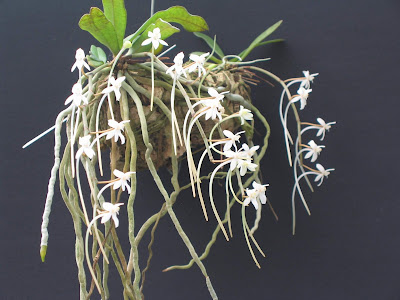Aerangis appendiculata is found in Malawi, Mozambique, Zambia, and Zimbabwe. It occurs in a variety of habitats from evergreen forests to thickets to woodland in areas with heavy rainfall. Plants usually are epiphytic at 1150-1850 m, growing at low levels on tree trunks in heavy shade, but they may occasionally be found as lithophytes, usually at higher elevations, growing in bright light.
Aerangis appendiculata also called as The Appendaged Aerangis, Mystacidium appendiculatum, is a species of the genus Aerangis. This species was described by Friedrich Richard Rudolf Schlechter in 1918.
IDENTIFY AERANGIS APPENDICULATA ORCHID PLANT
Aerangis appendiculata is found in Malawi, Mozambique, Zambia, and Zimbabwe. It occurs in a variety of habitats from evergreen forests to thickets to woodland in areas with heavy rainfall. Plants usually are epiphytic at 1150-1850 m, growing at low levels on tree trunks in heavy shade, but they may occasionally be found as lithophytes, usually at higher elevations, growing in bright light.
It is a miniature sized, warm to cool growing epiphyte or sometimes as a lithophyte in brighter light with a short stem carrying 3 to 4, oblanceolate, fleshy or leathery, dark green leaves often with visible reticulate venation.
The Appendaged Aerangis blooms in the spring on an axillary, pendant, 7.5 to 15 cm long, to 10 flowered, slightly fractiflex inflorescence. The flowers are erect, white, with pinkish pedicel and spur.
AERANGIS APPENDICULATA ORCHID PLANT CARE AND CULTURE
Cultural information should only be used as a guide, and should be to be adapted to suit you. Your physical location; where you grow your plants, how much time you have to devote to their care, and many other factors, will need to be taken into account. Only then can you decide on the cultural methods that best suit you and your plants.
Light:
Aerangis appendiculata needs a light level of 10000-30000 lux., but the plants probably grow better at 15000-23000 lux. Light should be filtered or diffused, and the plants should not be exposed to direct midday sun. Strong air movement should be provided at all times.
Temperature:
Summer days temperatures at average 25-26°C, and nights average 16°C, with a diurnal range of 9-10°C. The warmest season occurs in spring at the end of the long winter dry season. Spring days average 26-28°C, nights warm from 9°C to 15°C, and the diurnal range falls from 17°C to 13°C. during the season.
Humidity:
The Appendaged Aerangis need the humidity of 75-85% in summer and early autumn, dropping gradually to near 50% in early spring at the end of the dry season.
Substrate, growing media and repotting:
Aerangis appendiculata usually grows better and its pendent flower spikes and blossoms with extremely long spurs are more easily displayed when plants are mounted on slabs of rough bark. Mounted plants need high humidity and must be watered or misted at least once a day, however, and during hot, dry weather they may require several waterings a day.
They may also be grown in small (8-13 cm) hanging pots or baskets using a very coarse, open, fast-draining medium to anchor the plant but allowing the roots to wander outside the container.
Plants should be repotted if the medium starts to break down. Repotting done just as new roots start to grow enables the plant to become reestablished in the shortest possible time. If the leaves start to shrivel or wrinkle or show other signs of stress, the plant usually will recover and grow well if soaked in water for about 20 minutes at least 3 times a week.
Watering:
Rainfall in the habitat is heavy in summer and early autumn. Averages then drop rather rapidly into a dry season that extends from mid autumn to early spring. Cultivated plants should be watered heavily while actively growing, but drainage must be excellent with good aeration around the roots. Conditions around the roots should never become stale or soggy. Water should be gradually reduced in autumn after new growths have matured.
Fertilizer:
1/4-1/2 recommended strength, applied weekly when plants are actively growing. You can use a high-nitrogen fertilizer from spring to midsummer, then switch to one high in phosphates in late summer and autumn.
Rest period:
Winter days temperature average 22-24°C, and nights average 5-6°C, with a diurnal range of 17-18°C. Although the plants in the wild obviously survive brief exposures to temperatures below freezing, cultivated plants are probably healthier if not exposed to such extreme conditions. If plants are subjected to cold conditions, they will survive with less damage if they are dry at the time.
Water should be greatly reduced for cultivated plants in winter with fairly regular early morning misting provided between rather infrequent light waterings in autumn and early winter. In late winter, however, water should be reduced further with only occasional misting between infrequent waterings. Water should be increased somewhat if leaves shrivel or show other signs of stress. Fertilizer should be eliminated until new growth starts and heavier watering is gradually resumed in spring.














COMMENTS